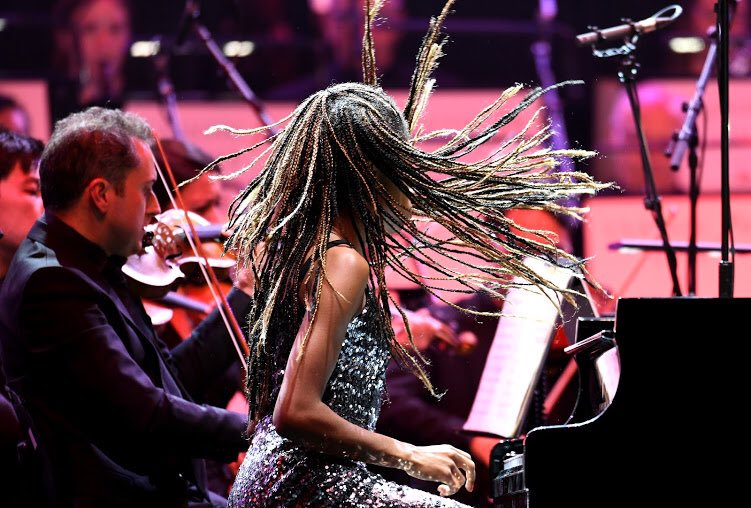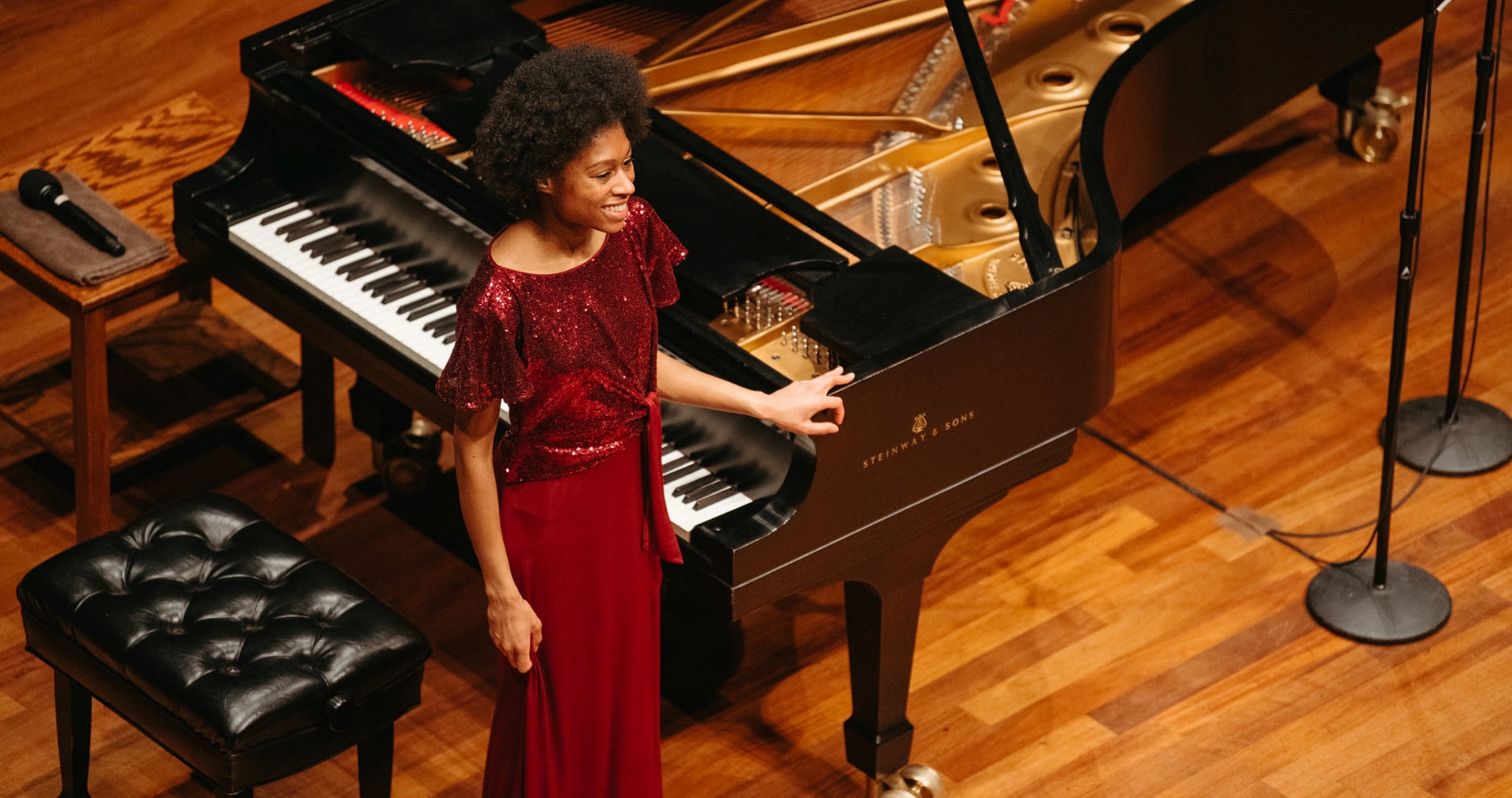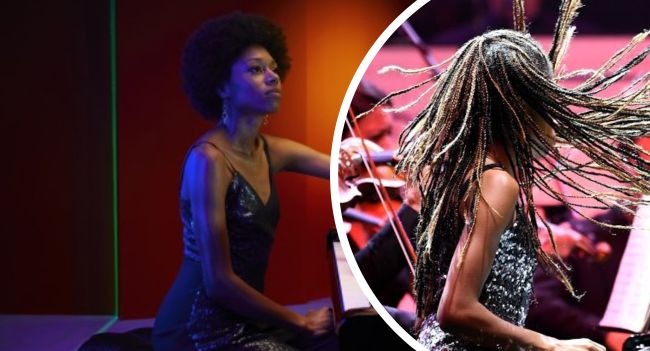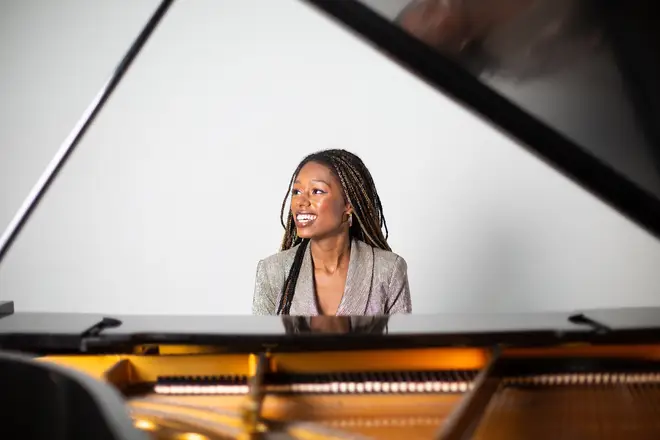 United Kingdom Richard Strauss, Beethoven, Sibelius: Isata Kanneh-Mason (piano), Hallé / Sir Mark Elder (conductor). Recorded (directed by Jonathan Haswell) at The Bridgewater Hall, Manchester, available from 18.3 to 18.6.2021. (JPr)
United Kingdom Richard Strauss, Beethoven, Sibelius: Isata Kanneh-Mason (piano), Hallé / Sir Mark Elder (conductor). Recorded (directed by Jonathan Haswell) at The Bridgewater Hall, Manchester, available from 18.3 to 18.6.2021. (JPr)

R. Strauss– Serenade, Op.7
Beethoven– Piano Concerto No.3 in C minor, Op.37
Sibelius – Symphony No.3 in C major, Op.52
As Spring is with now upon us, the Hallé resumes its 20/21 Winter Season because their music director Sir Mark Elder explained, ‘we’ve had to wait a bit until after the furlough arrangement’.
Richard Strauss’s Serenade was composed – we were told by Elder – ‘when he was 17’ and how it was ‘an amazing achievement, a really gorgeous piece’. Everything is, of course, in the ear of the beholder and I thought it sounded the work of a teenager. I am not certain how often it has been performed by any of the 13 horn and woodwind players involved as they were concentrating hard on their music so, for me, it could have done with a little more polish. It is a short (ten-minute) single movement, basically serene, though it builds to a brief imposing climax before subsiding once more for a quiet ending. It sounded very much like a song without words.
Isata Kanneh-Mason was playing with the Hallé for the first time. Elder asked her how the large and immensely talented Kanneh-Mason family had survived our recent troubled times and we were told how during ‘the first lockdown last year we were together for the whole 5 months in our home in Nottingham and that was really lovely because it meant we could play chamber music together’ and that the older ones are ‘now in different places in London’ but are ‘still close’. Beethoven’s Third Piano Concerto is Isata’s favourite of his five, ‘I’ve been playing it on and off for a year or so and there’s always more to discover when you come back to the piece’ and she agreed with Elder that there was ‘so much drama’ in it.
Because the concerto opens with an orchestral exposition of the theme before we first hear the soloist, there was an opportunity to see the maskless players spaced well apart at individual music stands. The Allegro con brio first movement was (surprisingly to me) Mozartian and with the first ascending scale it is possible to admire Kanneh-Mason’s mesmerisingly light fingerwork from all the rapid runs across the keyboard. Her sparkly green gown was the only flashy thing about Kanneh-Mason’s restrained – almost laidback – and crystalline playing. Through Beethoven’s cadenza and on to the coda the movement becomes a trill- and arpeggio-fest; with more to come in the remainder of the work. After some repose during the cadenza there is a stormy ending and during the coda the soloist’s left hand comes into more prominence with some chords to accompany further right hand fireworks. Hushed strings begin the ascent to a crescendo for the entire orchestra which ushers in the final shattering bars. The virtuosity of Kanneh-Mason and the support of Elder and his orchestra were splendid here.

The second movement (Largo) has a heartfelt – almost mournful – opening on solo piano. It is slow, gentle, and lyrical music and there is a subdued culmination when the ears can be deceived into thinking we hear the ticking of a clock and the musical passing of time. That it is also so meditative only confirms the depth of feeling which Kanneh-Mason imbues into nearly all her notes and how responsive she is to the contribution of the musicians around her. The final movement (Rondo-Allegro) is jaunty and rather more optimistic in comparison with what has gone before. This is Beethoven at his most playful. It is slightly episodic as a simple tune evolves into something more complex. It is fascinating to watch in closeup Kanneh-Mason’s lightning-fast hands and indeed there is a final flourish up and down the keys before the timpani signals the affirmative conclusion to the concerto.
Mark Elder gave a long, though interesting, introduction to Sibelius’s Third Symphony starting by saying how when young ‘the first concert that my mother ever took me to in London at the Royal Festival Hall was to hear the Second Symphony and it was that symphony that was the first ever [Sibelius] symphony to be played in this country and that premiere was given by the Hallé’. He went on to say that the Third we would hear was however ‘different in musical atmosphere, no less powerful but without that vein of Romanticism that we come to associate with the First and the Second Symphony.’ Elder said how the Third ‘belongs to a new form of classicism’ and that this came about from Sibelius’s frequent visits to Berlin during the first decade of the twentieth century ‘to see what the trends were in contemporary music’. Because – according to Elder – Sibelius made ‘every note count’ it meant he was the complete opposite to Gustav Mahler. Apparently the two composers actually met and ‘disagreed about what a symphony should be’. Having heard the Third Symphony for the first time I know which composer I prefer, and it isn’t Sibelius.
There is a strident opening in cellos and double basses to the first movement (Allegro moderato), a subsequent flute solo suggests bird song, there is agitation in the strings as the volume and tempo increases for the first of three climaxes. In between are more pastoral moments and after the final outburst the music winds down before two dramatic chords.

The second movement (Andantino con moto, quasi allegretto) contains passages of silkily seductive music (I imagined an Arabian dance). There are pizzicato strings and good work from oboe, flute and clarinet despite the movement being rather repetitive and developing a reflective sense of musical ennui.
The Moderato we were told by Elder is two movements in one, a Scherzo and finale, and he told us how eventually there is ‘something clear and positive out of fragments’. I thought that it was as if Sibelius has invented deconstructed music; indeed he described it himself as ‘the crystallisation of chaos’. Those thematic ‘fragments’ old and new begin to coalesce and there is another punctuating burst of orchestral sound and the steady tread of cellos and double basses. Eventually a stronger theme gains the upper hand, building march-like at first and ending triumphantly even though the music just stops, like the first movement also did.
Elder’s layering of sound was masterly throughout and the Hallé exemplary with many of them worthy of praise but particularly catching the ear and eye were Stéphane Rancourt’s oboe, the flutes of Amy Yule and Sarah Bennett, Hannah Perowne who was leading the orchestra, Sergio Castelló López’s clarinet and Erika Öhman’s sterling work on timpani.

